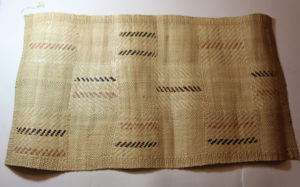An interview was conducted with Museum Anthropology student Alex Crowell. In here, she discusses one of the projected themes within the upcoming exhibition–Resting.

Why did you decide to choose the Samoan Sleeping Mat?
At first, I was surprised by its size. For a sleeping mat, I was assuming something larger but quickly realized that was an opinion formed in judgment. I thought aesthetically it was simplistic in nature, comparative to other objects in the room and one I had chosen previously belonging to China and Southern Asian aesthetic influences (notorious in their style and patterns). Furthermore, I had seen images and depictions of Polynesian fabrics before, so was surprised by the lack of vibrancy in this one. I knew, based on these observations, it had to have been older, and less culturally significant as other textile counterparts.
What was a surprising and/or interesting fact about this object?
How it was used in a communal sense. The fala moenga was an individuals mat, and was treasured as an individualistic object; however, it was used frequently and was multipurpose. For example, one’s fala moenga was brought to community meetings or gatherings, carrying home with you wherever you go. It symbolized wealth, and how one sits on the fala moenga is an indicator of cultural reformity, and was important to the public perception. To show one’s bare feet towards another individual was considered an immense offense, thus the soles of the feet should be turned at all times.
How does this object fit into the greater theme of Resting?
While it has a communal aspect to it, the fala moenga is purposeful in its use by the individual. Utilitarian purposes lie towards the individual no matter its connotations. The “resting” section of the exhibit familiarizes visitors with the more privatized concept of resting associated with home: senses of comfort, stability, and an internal solidarity that can be attributed across most cultures.
What is your vision for this section, and how would you like to portray it to the public?
My hope is that it will show how personalized and specific resting is, yet also how its intentions are the same no matter which culture one adheres to. My hope is to illustrate this notion to visitors, for them to feel that familiarity when looking at the resting section that they associate with the act while challenging their preconceived notions as to what implications are attributed to resting.
I want to portray this by creating displays in which visitors can associate with the objects, while also providing juxtaposition with how comfort appears differently depending on the individual and community.
How are you attempting to make this section relatable for visitors while still encompassing a wide breadth of cultures?
This aspect has proven the most difficult part of exhibit designing, so I will answer both this question and the next question here. Making an exhibit that is relatable to the visitor, adheres to the cultural properties associated with the objects, and challenges Western notions associated with the concept of “Home” was a difficult task. We constructed a familiarity in our categorization, one that we strongly believe adheres to multiple cultures, including Western.
More importantly, the placement of objects into groups, while mainly utilitarian in some regards, also supported aspects of different values to the culture behind the object. We found it was imperative to have objects placed in different sections in order to juxtapose any Western implications that would be imposed by visitors.
